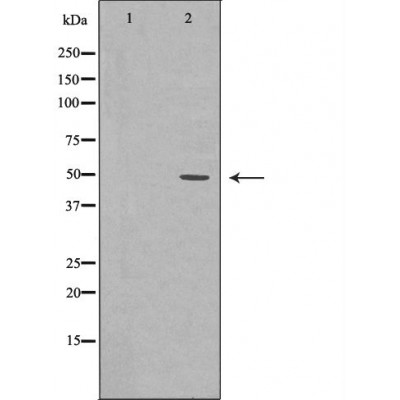BMP4 Antibody - #DF6461
| Product: | BMP4 Antibody |
| Catalog: | DF6461 |
| Description: | Rabbit polyclonal antibody to BMP4 |
| Application: | WB IHC |
| Reactivity: | Human, Mouse, Rat |
| Prediction: | Zebrafish, Bovine, Sheep, Rabbit, Dog, Chicken |
| Mol.Wt.: | 47kDa; 47kD(Calculated). |
| Uniprot: | P12644 |
| RRID: | AB_2838423 |
Product Info
*The optimal dilutions should be determined by the end user. For optimal experimental results, antibody reuse is not recommended.
*Tips:
WB: For western blot detection of denatured protein samples. IHC: For immunohistochemical detection of paraffin sections (IHC-p) or frozen sections (IHC-f) of tissue samples. IF/ICC: For immunofluorescence detection of cell samples. ELISA(peptide): For ELISA detection of antigenic peptide.
Cite Format: Affinity Biosciences Cat# DF6461, RRID:AB_2838423.
Fold/Unfold
zgc:100779; BMP 2B; BMP 4; BMP-2B; BMP-4; BMP2B; BMP2B1; BMP4; BMP4_HUMAN; Bone morphogenetic protein 2B; Bone morphogenetic protein 4; DVR4; MCOPS6; MGC100779; OFC11; zbmp-4; ZYME;
Immunogens
A synthesized peptide derived from human BMP4, corresponding to a region within the internal amino acids.
Expressed in the lung and lower levels seen in the kidney. Present also in normal and neoplastic prostate tissues, and prostate cancer cell lines.
- P12644 BMP4_HUMAN:
- Protein BLAST With
- NCBI/
- ExPASy/
- Uniprot
MIPGNRMLMVVLLCQVLLGGASHASLIPETGKKKVAEIQGHAGGRRSGQSHELLRDFEATLLQMFGLRRRPQPSKSAVIPDYMRDLYRLQSGEEEEEQIHSTGLEYPERPASRANTVRSFHHEEHLENIPGTSENSAFRFLFNLSSIPENEVISSAELRLFREQVDQGPDWERGFHRINIYEVMKPPAEVVPGHLITRLLDTRLVHHNVTRWETFDVSPAVLRWTREKQPNYGLAIEVTHLHQTRTHQGQHVRISRSLPQGSGNWAQLRPLLVTFGHDGRGHALTRRRRAKRSPKHHSQRARKKNKNCRRHSLYVDFSDVGWNDWIVAPPGYQAFYCHGDCPFPLADHLNSTNHAIVQTLVNSVNSSIPKACCVPTELSAISMLYLDEYDKVVLKNYQEMVVEGCGCR
Predictions
Score>80(red) has high confidence and is suggested to be used for WB detection. *The prediction model is mainly based on the alignment of immunogen sequences, the results are for reference only, not as the basis of quality assurance.
High(score>80) Medium(80>score>50) Low(score<50) No confidence
Research Backgrounds
Induces cartilage and bone formation. Also acts in mesoderm induction, tooth development, limb formation and fracture repair. Acts in concert with PTHLH/PTHRP to stimulate ductal outgrowth during embryonic mammary development and to inhibit hair follicle induction (By similarity).
Secreted>Extracellular space>Extracellular matrix.
Expressed in the lung and lower levels seen in the kidney. Present also in normal and neoplastic prostate tissues, and prostate cancer cell lines.
Belongs to the TGF-beta family.
Research Fields
· Cellular Processes > Cellular community - eukaryotes > Signaling pathways regulating pluripotency of stem cells. (View pathway)
· Environmental Information Processing > Signal transduction > TGF-beta signaling pathway. (View pathway)
· Environmental Information Processing > Signal transduction > Hippo signaling pathway. (View pathway)
· Human Diseases > Cancers: Overview > Pathways in cancer. (View pathway)
· Human Diseases > Cancers: Specific types > Basal cell carcinoma. (View pathway)
· Organismal Systems > Endocrine system > Thyroid hormone signaling pathway. (View pathway)
Restrictive clause
Affinity Biosciences tests all products strictly. Citations are provided as a resource for additional applications that have not been validated by Affinity Biosciences. Please choose the appropriate format for each application and consult Materials and Methods sections for additional details about the use of any product in these publications.
For Research Use Only.
Not for use in diagnostic or therapeutic procedures. Not for resale. Not for distribution without written consent. Affinity Biosciences will not be held responsible for patent infringement or other violations that may occur with the use of our products. Affinity Biosciences, Affinity Biosciences Logo and all other trademarks are the property of Affinity Biosciences LTD.
